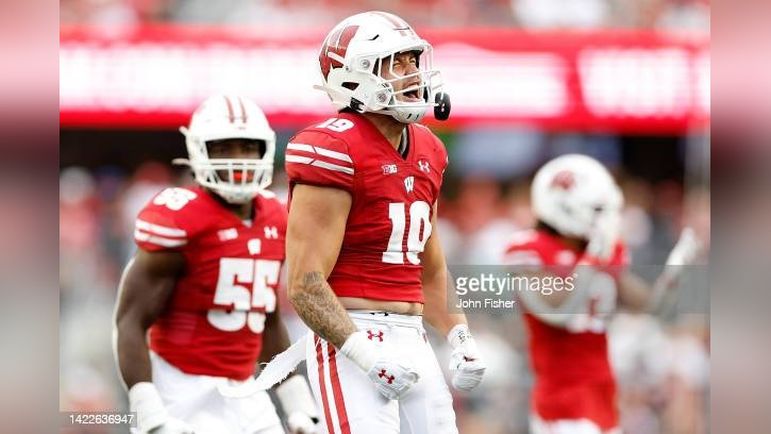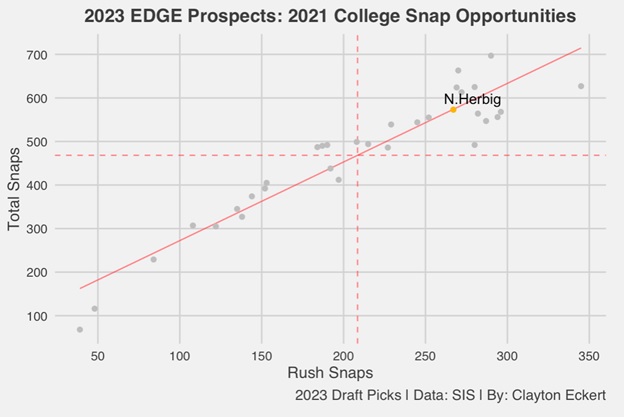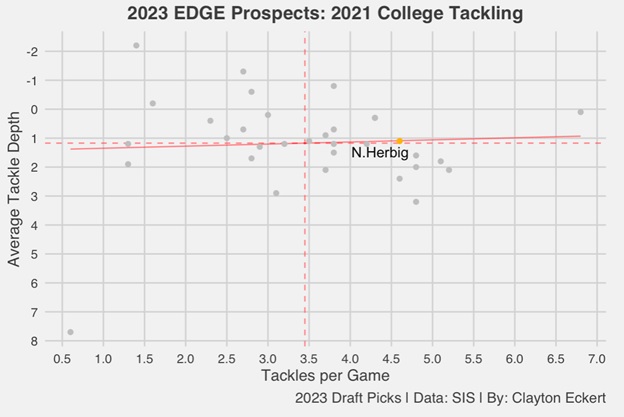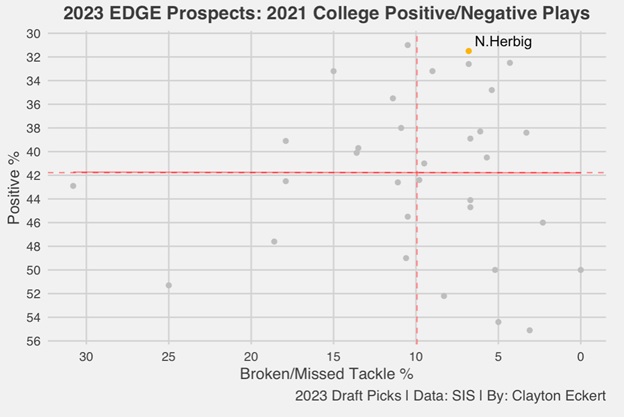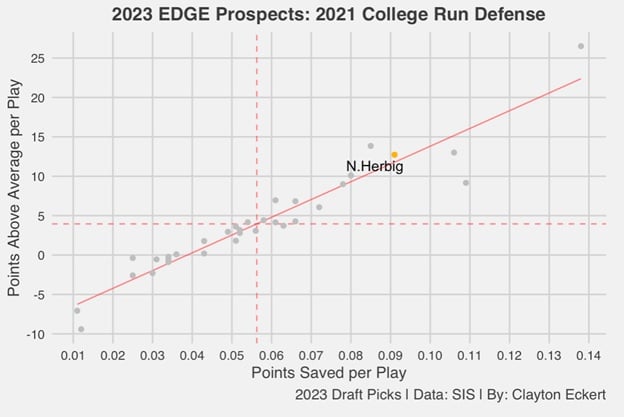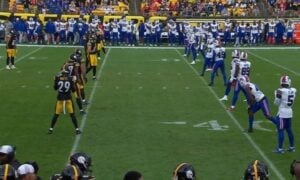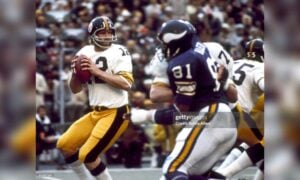Continuing the series, I wanted to look at the edge rusher position, at which Pittsburgh selected Nick Herbig in the fourth round. In the pre-draft process, there was much conversation on Herbig potentially moving to the inside linebacker position in the NFL, but general manager Omar Khan is leaving the door open for him to play both, at least initially. With all this in mind, and considering Herbig played the vast majority of his snaps on the edge for Wisconsin, this article will look at run defense at the position in 2021 using Sports Info Solutions (SIS), following my 2022 pass rush and run defense studies, along with a 2021 pass rush article.
Today I’ll focus on players who heard their names called in the draft, including other players who were debatable edge/linebacker “tweeners,” and two players were excluded due to SIS not tracking smaller schools. The goal is to see how Herbig stacked up among his peers.
First, let’s look at run snaps along with their total snaps to get a gauge of the players’ opportunities, and how often they were able to stay on the field for their squads last season:
In 2021, Herbig was above the mean in both data points, with 573 total snaps (seventh) and 267 rush snaps (12th) out of the 33 qualifying players, providing great availability while playing in every game. Comparing this to last season, he had 503 total snaps (21st) and 235 rush snaps (T-16th), a more average number of snap opportunities when he missed just one game with a knee injury. Important quantity context as we dive deeper into his quality of play and compare his final two college seasons.
Next, let’s look at a very important aspect of being a quality run defender: tackling. The chart below looks at the players’ tackles per game and average tackle depth, with the latter suggesting quality play up front and attacking the line of scrimmage:
Herbig fared best in tackles per game (4.6), which tied for seventh, and was right at the mean with a 1.1 average tackle depth that tied for 15th. He had an eerily similar 4.7 tackles per game in 2022, which ranked ninth, and vastly improved to a -0.5 average tackle depth that ranked sixth. While the signing of veteran edge rusher Markus Golden will likely limit Herbig’s opportunities on defense out of the gate, this is an encouraging improvement, providing disruption behind the line for Wisconsin. It will be interesting to see if he can translate this valuable skill to the NFL, which of course is a whole different animal.
This next view attempts to weigh positive and negative plays, using broken and missed tackle rates (negative plays) along with Sports Info Solutions positive play %, which is the rate of run plays with the player on the field resulted in a positive expected points added (EPA), with lower percentages being the best:
Here we see an encouraging element of Herbig’s 2021 season, ranking second in positive percentage (31.5%) along with a respectable 6.8% broken/missed tackle rate that tied for 14th. He also fared well last season with a 32.8% positive play rate, which ranked fourth, but unfortunately regressed in the latter, with an 11.9% broken/missed tackle percentage that dropped to 20th. Herbig was charted for five missed tackles and two broken tackles by SIS last season, compared to two of each in 2021 on similar opportunities. Here’s to hoping he can return to that form as he begins his journey in the black and gold, which will definitely be high on my radar.
To close, here is a more total view of the players in the run game using points saved per play (The total of a player’s EPA responsibility on run plays using the Total Points system that distributes credit among all players on the field for a given play (with positive numbers being good). Totals are scaled up to map to the average points scored or allowed on a team level, with the player’s snap count determining how much to adjust. For run defense, that includes accounting for defenders in the box, blown blocks forced, broken tackles, turnovers, and turnover returns.) and points above average per play (using the same Total Points system and putting a number to their value above an average level player):
When taking more things into account, Herbig fared extremely well in 2021 among his peers, ranking fourth in points saved per play and points above average per play. His impressive results included two forced fumbles and a fumble recovery, compared to matching the forced fumble number but no recoveries last year, when he ranked 20th and 21st in points saved and points above average.
So, Herbig fared better overall as a run defender in 2021, with top 10 ranks in positive percentage (second), points saved per play (fourth), points above average per play (fourth), total snaps (seventh), and tackles per game (T-seventh). He was also above average in rush snaps (12th) and broken/missed tackle rate (14th), which points to some optimism to improve his less desirable 2022 campaign in this regard. Herbig was slightly above the mean in average tackle depth in 2021 (15th) and was impressively above average in every aspect of the study.
Last season, Herbig was above average in positive rate (fourth), average tackle depth (sixth), tackles per game (ninth), and slightly above the mean in rush snaps (T-16th). He was slightly below average in this year’s draft class in total snaps (21st), while landing below the mean in the following important metrics in the run game: broken/missed tackle percentage (20th), points saved per play (20th), and points above average per play (21st). His average tackle depth was the only number that improved last year. That is discouraging on many levels, but Herbig displayed the valuable trait in disrupting plays behind the line of scrimmage that he can hopefully carry over to the NFL.
As expected, Herbig fared better as a pass rusher and showed the desired positive trajectory in his final season that justifies him starting his journey on the edge in Pittsburgh in my opinion, but in totality raised some concerns, particularly last year as we anticipate his run defense.
I do think he could find more success if he moves to inside linebacker, with defensive lineman likely keeping him more free to utilize his instincts at the line of scrimmage. One thing’s for sure: I can’t wait to see how it pans out for Herbig this year and beyond.
Throughout the rest of the offseason, I will dive deeper into the data as we continue to learn about the newest Pittsburgh Steelers. How do you think Herbig will fare his rookie year? Thanks for reading and let me know your thoughts in the comments!

